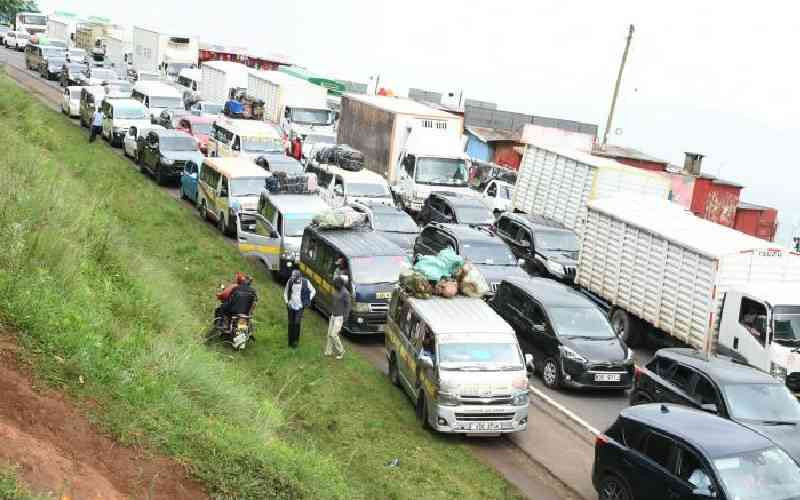Traffic congestion has become an inseparable part of urban life. Motorists and commuters spend considerable amounts of time sitting in traffic jams. In Nairobi, for instance, it gets worse every day, especially during peak hours or when it rains.
Traffic snarl-ups are so common that there is a high likelihood you are stuck in traffic at this moment while reading this article.
Besides lost man-hours, the effects of traffic congestion are overwhelming. It has been linked to stress, anxiety and air pollution.
As you sit in a traffic ‘jam’ on your way to work, you become exposed to toxins that adversely affect your health because vehicles stuck in a snarl-up with their motors running emit carbon waste into the atmosphere, which is then inhaled by you and the flora and fauna nearby.
Exposure to such toxins for prolonged periods, as occurs during a traffic ‘jam’, is responsible for the increase in many respiratory ailments that are a burden to families and our healthcare system.
The noise pollution that accompanies such congestion is equally dangerous. Noise pollution is known to increase stress and anxiety, increasing the possibility of succumbing to road rage, which feeds the vicious cycle. It is no wonder that many Nairobians often suffer from the effects of accumulated stress.
Seed capital
Over and above the psycho-social impact of traffic congestion, there are social, economic and even political ramifications. The productivity lost as people waste precious time sitting in a traffic jam, the cost of fuel burnt in the meantime, adds an enormous strain to an already demanding city life. According to estimates by KeNHA, the city loses Sh50 million everyday to traffic jams.
This translates into a staggering Sh18.25 billion every year, not counting the many opportunities lost; whether as employment or investment. What if traffic congestion could be reduced by half? We could save up to Sh6 billion.
This money could be channeled into funding youth programmes through paid internships and placements for young people looking for meaningful employment or subsidised seed capital for start-ups, or build capacity for young people by training them for the job market to bridge the skills gap.
That aside, the actual cost of traffic jams in Nairobi is the frustration it causes to motorists who want to dash from point A to B. Most importantly, traffic has a huge bearing on our reputation as an investment destination and the region’s transport hub.
Consider that it is faster to fly to Kigali from Nairobi than it is for one to drive from JKIA to the city centre on any given day.
To me, the rising costs of the congestion problem on our roads justify bold efforts to revamp our infrastructure to incrementally ease congestion. From plans to develop a BRT system, to encouraging non-motorised transport among others, we need working solutions. This is why the conception of the Nairobi expressway is a welcome addition to our infrastructural landscape.
Pave way
Already, by-passes and link roads have provided alternative routes to motorists wishing to traverse regions without having to pass through the CBD.
Stay informed. Subscribe to our newsletter
Like a piece of puzzle, the elevated expressway will not solve all of Nairobi’s traffic problems, but will play its part in easing traffic by offering an ‘upstairs’ alternative to motorists - from Mlolongo through Uhuru Highway up to Westlands - at a fee. The incentive is for those rushing to close a business deal, attend patients or just for those thrilled by a smooth traffic flow.
There are pros and cons to the project. But the pros far outweigh the cons. However, public debate around the expressway have caused anxiety, and rightly so. Kenyans have a direct stake in the traffic congestion problem.
First, the question arose on whether Uhuru Park – a public park- will be hived off to pave way for the expressway. Based on initial estimation, 40 acres of land should be acquired for the entire project. The English people say that to make an omelette, you must break eggs. Prudently, KeNHA is optimising the design to reduce the need for acquisition of land.
Debate around the Sh60 billion double-decker road may also have stemmed from the fact that the expressway is the first major project that Kenya is undertaking under the Public Private Partnership arrangement.
Those concerns are warranted. Many are keen to follow the success of the entire project. Not to forget that the project actually bears a considerable risk. The plan is that the contractor will recoup the capital through toll charges; what if doesn’t break even soon as expected? What happens to the capital invested? Nonetheless, Nairobi’s long suffering motorists deserve a solution, soon.
Mr Mokamba comments on social issues
 The Standard Group Plc is a
multi-media organization with investments in media platforms spanning newspaper
print operations, television, radio broadcasting, digital and online services. The
Standard Group is recognized as a leading multi-media house in Kenya with a key
influence in matters of national and international interest.
The Standard Group Plc is a
multi-media organization with investments in media platforms spanning newspaper
print operations, television, radio broadcasting, digital and online services. The
Standard Group is recognized as a leading multi-media house in Kenya with a key
influence in matters of national and international interest.
 The Standard Group Plc is a
multi-media organization with investments in media platforms spanning newspaper
print operations, television, radio broadcasting, digital and online services. The
Standard Group is recognized as a leading multi-media house in Kenya with a key
influence in matters of national and international interest.
The Standard Group Plc is a
multi-media organization with investments in media platforms spanning newspaper
print operations, television, radio broadcasting, digital and online services. The
Standard Group is recognized as a leading multi-media house in Kenya with a key
influence in matters of national and international interest.









